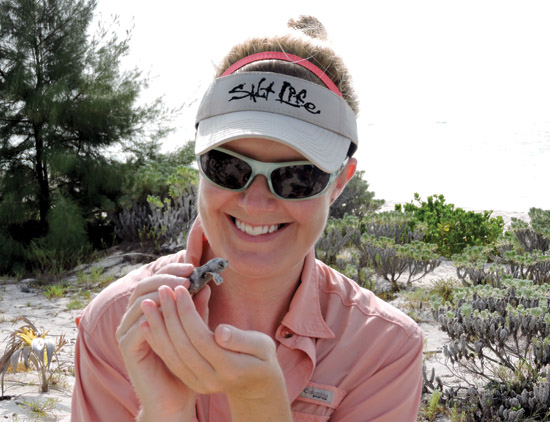The Great Escape: The Turtle Hatchlings of Little Cayman

Volunteer payoff as turtle hatchlings high tail it for the sea
On a quiet Little Cayman beach this July 5th, a small group of excited – and lucky – turtle watch volunteers witnessed the hatching of the island’s first turtle nest of the season. It was a rare event and for the volunteers who walk the island’s beaches May to November to spot and protect turtle nests, it was the ultimate payoff.
“It’s incredibly difficult to catch a nest hatching,” said Jennifer Mills, general manager of the Southern Cross Club resort and long time volunteer. “We had an idea the Loggerhead nest might hatch that Saturday night,” she said, and although the watchers were right, they still almost missed the great escape. “We could tell from the tiny tracks that most of the turtles had made it safely to the sea,” she said. But the volunteers were in luck; four babies remained for them to watch as they struggled out of the nest and made their dash to the relative safety of their water world. It was a huge relief to know they’d at least made it that far, even if they have a long way to go,” she said. “We couldn’t contain our excitement that night,” she recalls. “Witnessing this was so overwhelmingly wonderful. I feel very privileged to have
been part of it.” In eleven years on the turtle watch, Mills has seen a nest hatching just three or four times.
Fellow volunteer and Southern Cross Club co-worker Renita Schouten was on hand for the big event, too. “It was incredible. Being a turtle watch volunteer is one of the coolest things to do here,” she said. “It’s a great project, all for the good of the island.”

Turtle Team
The government’s turtle conservation program relies on volunteers like Mills, Schouten and other Little Cayman residents to help find and monitor nests during the season. Personnel at local resorts target specific beaches and together clear trash and keep an eye out for turtle activity. Beachfront homeowners also help out by walking their beaches. And group walks are organized as well. The team effort covers all the crucial areas, Mills says.
“When the nesting is in full swing there are so many nests it’s essential that everyone comes together to support the project and help protect our turtles,” Mills said. “We’re very lucky on Little Cayman to have a community that genuinely cares about the island; residents are conservation minded and have an avid interest in protecting the marine environment.”
During May and June sea turtles mate and the females come ashore to lay their eggs on the beach. In one of Mother Nature’s mysteries, the turtles that were hatched from nests on Little Cayman beaches return to those same beaches to lay their eggs later in life. As the volunteers cover the beaches they report their findings by calling the Sea Turtle Hotline 345-938-NEST. New turtle nests are marked and protected and all the data are recorded. Department of Environment Research Officer Janice Blumenthal says that thanks to the Southern Cross Club and the rest of the Little Cayman Community, more than 30 turtle nests have already been found, marked and protected.
Historically, the waters around all three Cayman islands have been home to Green, Loggerhead, Hawksbill and Leatherback turtles. Once abundant, the turtle populations declined almost to extinction because of commercial fishing.The Department of Environment conservation program raises awareness on Grand Cayman, Little Cayman and Cayman Brac, educating the public on the need and how-to of turtle protection, and it’s working. The sea turtles are making a comeback.
The Department of Environment began surveying beaches in 1998 to identify turtle nests and track the nesting season, and from the start asked the community to help. Beachfront property owners and resort managers are encouraged to use only turtle friendly lights, or turn off other lights during the May to November season.

Turtle Tourists
Turtle eco-tourism has developed as a direct result of island resorts protecting the nests and giving a leg up to the hatchlings. The season starts with Loggerhead nests, then the other species follow later in the following months. Females surviving to adulthood,
it’s hoped, will eventually return to nest on the same Little Cayman beach where they were born.
Meantime, Mills and her fellow volunteers, in the company of an officer with the Department of Environment, returned to excavate the nest that hatched in early July so they could count the shells to determine the number of hatchlings. Their mission was to rescue and release any baby turtles that may have hatched late and remove eggs that didn’t develop. All this information is recorded for the conservation program and added to the government data base.
Though sea turtles are making a comeback in the Cayman islands, the global population of these highly migratory animals is either endangered or threatened. Actions of volunteers on the beaches of Little Cayman contribute to the survival of these species. Yay!
For more on turtles: www.doe.ky
The Southern Cross Club: www.southerncrossclub.com
Cayman Islands: www.caymanislands.ky / www.divecayman.ky







